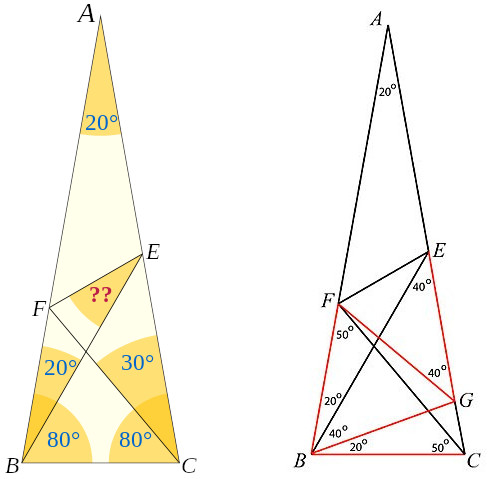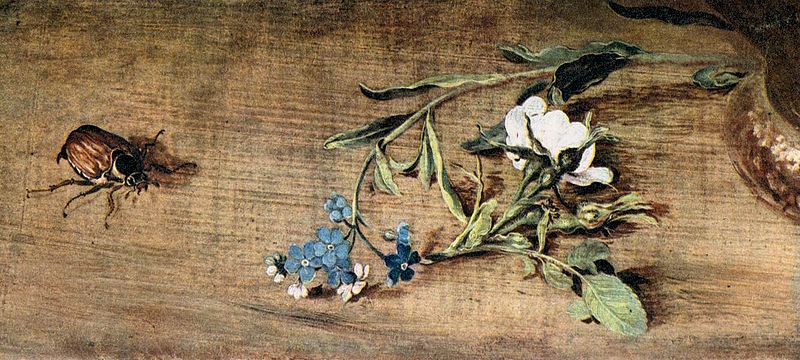The score of Michael Finnissy’s 2004 composition Back on Earth is designed “to roughly convey an impression of Saturn’s rings.”
Read more and listen here.
The score of Michael Finnissy’s 2004 composition Back on Earth is designed “to roughly convey an impression of Saturn’s rings.”
Read more and listen here.

Astronomer Clyde Tombaugh assembled his first telescope from spare parts on his family’s Kansas farm — the crankshaft of a 1910 Buick, a cream-separator base, and mechanical components from a straw spreader. He used this to make sketches of Jupiter and Mars that so impressed the astronomers at Lowell Observatory that they gave him a job there.
Years later, after he had made his name by discovering Pluto, the Smithsonian Institution asked if it could exhibit this early instrument. He told them he was still using it — he was making observations from his backyard near Las Cruces, N.M., until shortly before his death in 1997.
“Its mirror was hand-ground and tested in a storm cellar,” wrote Peter Manly in Unusual Telescopes in 1991. “It’s not the most elegant-looking optical instrument I’ve ever used, but it is one of the better planetary telescopes around. … Because of its role in the history of astronomy, I would classify this as one of the more important telescopes in the world.”

In 1880 art collector Charles Ephrussi commissioned Manet to paint A Bundle of Asparagus for 800 francs.
When Manet delivered the painting, Ephrussi gave him 1,000 francs.
So later that year Manet delivered the small painting below with a note: “There was one [sprig] missing from your bundle.”
(Thanks, Jon.)

The following story is true. There was a little boy, and his father said, ‘Do try to be like other people. Don’t frown.’ And he tried and tried, but could not. So his father beat him with a strap; and then he was eaten up by lions.
Reader, if young, take warning by his sad life and death. For though it may be an honour to be different from other people, if Carlyle’s dictum about the 30 millions be still true, yet other people do not like it. So, if you are different, you had better hide it, and pretend to be solemn and wooden-headed. Until you make your fortune. For most wooden-headed people worship money; and, really, I do not see what else they can do. In particular, if you are going to write a book, remember the wooden-headed. So be rigorous; that will cover a multitude of sins. And do not frown.
— Oliver Heaviside, “Electromagnetic Theory,” in The Electrician, Feb. 23, 1900
(When asked the population of England, Thomas Carlyle had said, “Thirty million, mostly fools.”)

Henry Dudeney in Strand, June 1911: “It would be difficult to find a prettier little chess problem in three moves, produced from such limited material as a rook and a pawn, than the one given this month, by Dr. S. Gold. The novice will probably find the task of discovering the key move quite perplexing. White plays and checkmates in three moves.”
From Chapter 12 of Ken Follett’s novel The Pillars of the Earth:
‘My stepfather, the builder, taught me how to perform certain operations in geometry: how to divide a line exactly in half, how to draw a right angle, and how to draw one square inside another so that the smaller is half the area of the larger.’
‘What is the purpose of such skills?’ Josef interrupted.
‘Those operations are essential in planning buildings,’ Jack replied pleasantly, pretending not to notice Josef’s tone. ‘Take a look at this courtyard. The area of the covered arcades around the edges is exactly the same as the open area in the middle. Most small courtyards are built like that, including the cloisters of monasteries. It’s because these proportions are most pleasing. If the middle is bigger, it looks like a marketplace, and if it’s smaller, it just looks as if there’s a hole in the roof. But to get it exactly right, the builder has to be able to draw the open part in the middle so that it’s precisely half the area of the whole thing.’
How is this done? Inscribe a diamond within a square and then rotate it 45 degrees:


The opening of England’s Liverpool and Manchester Railway in 1830 took a direful turn when William Huskisson, a member of Parliament for Liverpool, approached the Duke of Wellington’s railway carriage. Huskisson became so engrossed in their conversation that he failed to notice an oncoming train, and when he realized his danger and tried to climb into Wellington’s carriage, the door swung outward and deposited him in its path. His leg was badly mangled.
“Immediately after the accident, he was placed on the ‘Northumbrian’ — another of Stephenson’s engines — and raced to Liverpool at the then unprecedented speed of 36 m.p.h., with Stephenson himself as driver,” writes Ernest Frank Carter in Unusual Locomotives. “It was the news of this accident, and the speed of the engine, which was one of the causes of the immediate adoption and rapid spread of railways over the world. Thus was the death of the first person to be involved in a railway accident turned to some good account.”

Edward Mann Langley, founder of the Mathematical Gazette, posed this problem in its pages in 1922:
ABC is an isosceles triangle. B = C = 80 degrees. CF at 30 degrees to AC cuts AB in F. BE at 20 degrees to AB cuts AC in E. Prove angle BEF = 30 degrees.
(Langley’s description makes no mention of D; perhaps this is at the intersection of BE and CF.)
A number of solutions appeared. One, offered by J.W. Mercer in 1923, proposes drawing BG at 20 degrees to BC, cutting CA in G. Now angle GBF is 60 degrees, and angles BGC and BCG are both 80 degrees, so BC = BG. Also, angles BCF and BFC are both 50 degrees, so BF = BG and triangle BFG is equilateral. But angles GBE and BEG are both 40 degrees, so BG = GE = GF. And angle FGE is 40 degrees, so GEF is 70 degrees and BEF is 30 degrees.

Russian artist Anatoly Konenko works on an absurdly, almost unthinkably tiny scale. Trained as an engineer, he took up microminiature art in 1981, inventing his own instruments and techniques. Soon he was writing on grains of rice, poppy seeds, and even a human hair, and in 1994 he began to publish miniature versions of books by Mikhail Koltsov, Yevgeny Yevtushenko, and Alexander Pushkin. His 1996 edition of Chekhov’s Chameleon assembled 29 pages, three color illustrations, and a portrait of the author into a volume 0.9 millimeters square, at the time the smallest book in the world.
In other media, his feats include a 10-milliliter aquarium, a shod flea, a 1:40,000 scale balalaika, and a 17-millimeter chess set with 2-millimeter pieces. Above: a 3.2-millimeter proboscis midge holds a model of the Eiffel Tower. See his website for more — including a caravan of camels passing through the eye of a needle.

Pains and other such sensory processes may be long or short, continuous or intermittent; but in spite of Longfellow’s ‘long, long thoughts’, I do not think a thought (say, that the pack of cards is on the table, or that Geach’s arguments are fallacious) can significantly be called long or short; nor are we obliged to say that in that case every thought must be strictly instantaneous.
… [W]hat I am suggesting is that thoughts have not got all the kinds of time-relations that physical events, and I think also sensory processes, have. One may say that during half an hour by the clock such-and-such a series of thoughts occurred to a man; but I think it is impossible to find a stretch of physical events that would be just simultaneous, or even simultaneous to a good approximation, with one of the thoughts in the series. I think Norman Malcolm was right when he said at a meeting in Oxford that a mental image could be before one’s mind’s eye for just as long as a beetle took to crawl across a table; but I think it would be nonsense to say that I ‘was thinking’ a given thought for the period of the beetle’s crawl — the continous past of ‘think’ has no such use.
— Peter Geach, God and the Soul, 1969